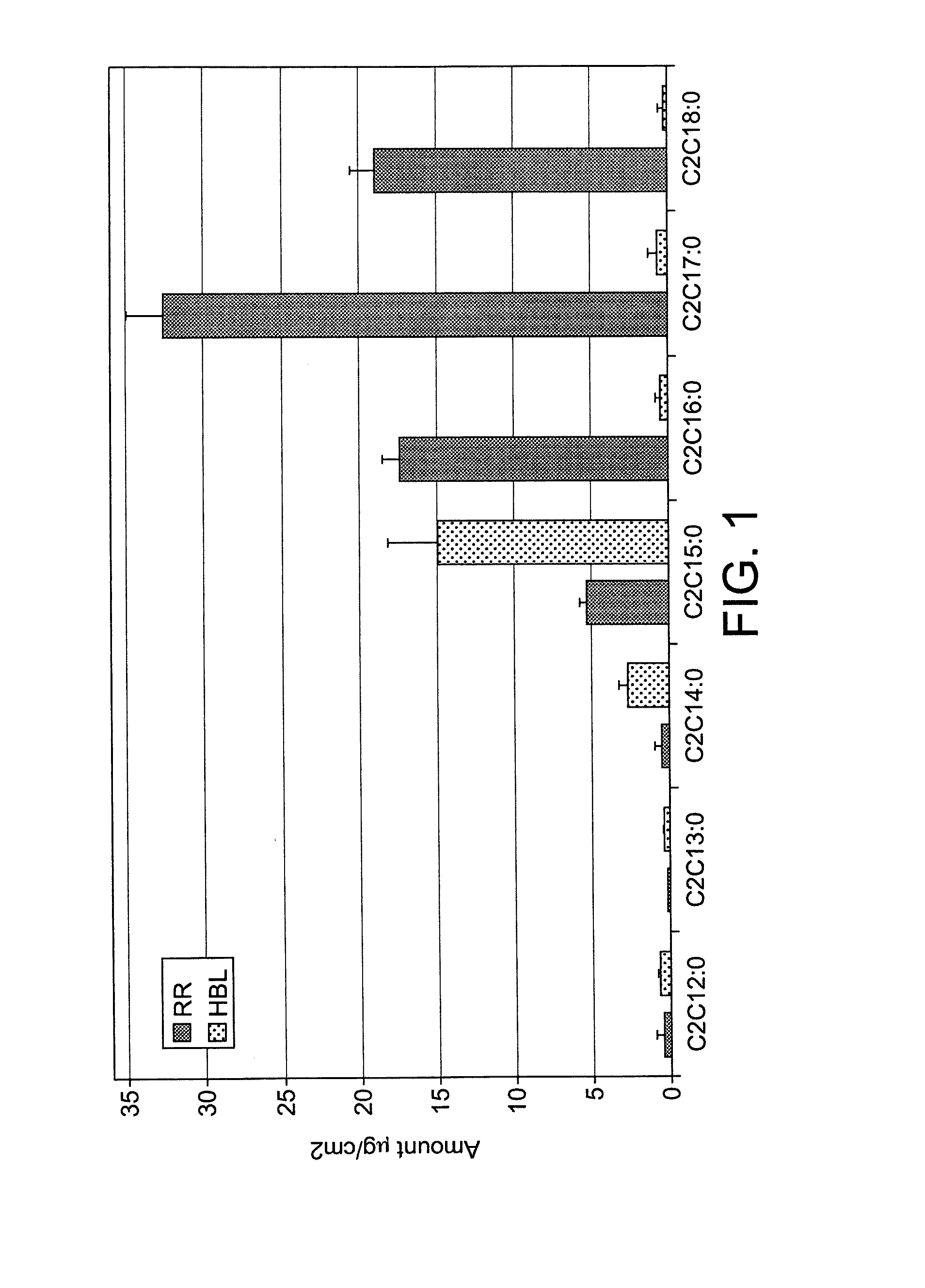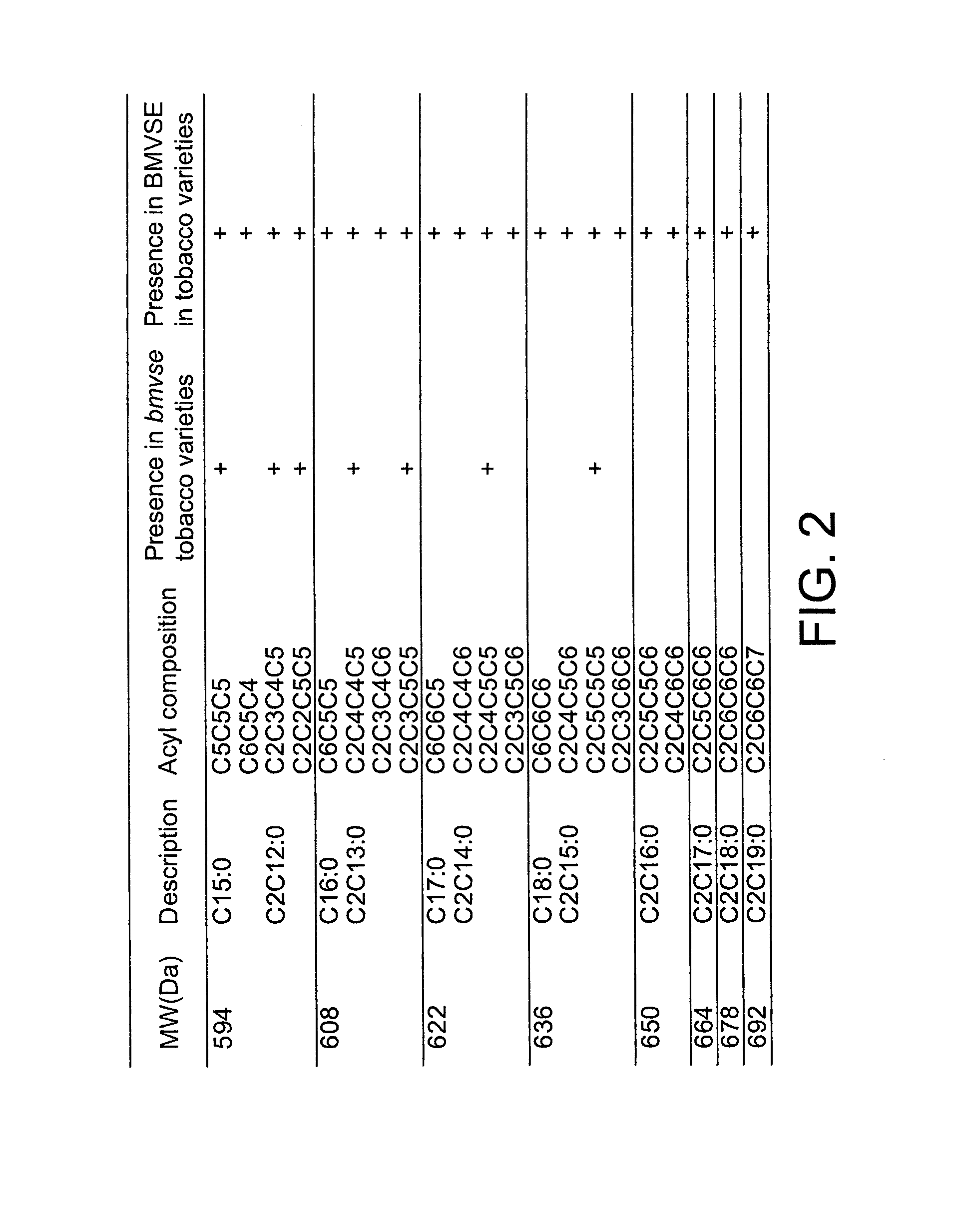Isopropylmalate synthase from nicotiana tabacum and methods and uses thereof
a technology of isopropylmalate and synthase gene, which is applied in the direction of transferases, tobacco, tobacco treatment, etc., can solve the problems of unacceptably reduced production yield, and achieve the effects of reducing production yield, reducing the overall metabolism of the plant, and changing the composition of sucrose ester
- Summary
- Abstract
- Description
- Claims
- Application Information
AI Technical Summary
Benefits of technology
Problems solved by technology
Method used
Image
Examples
example 1
Sucrose Ester Analysis in the Nicotinia tabacum Varieties of Flue Cured Hicks Broadleaf (HBL) and Primitive Red Russian (RR)
[0255]To study sucrose ester synthesis in tobacco, two model varieties are chosen: the flue cured Hicks Broadleaf (HBL) and the primitive Red Russian (RR). Initial data available from the National Genetic Resources Program (Germplasm Resources Information Network—(GRIN), National Germplasm Resources Laboratory, Beltsville, Md.) catalogue suggests a different content in beta-methylvaleryl containing sucrose ester content between these two lines.
[0256]The composition of HBL and RR leaf exudates in sucrose esters is analysed and the results are presented in FIG. 1. RR sucrose ester composition differs from HBL sucrose ester composition. In HBL, sucrose esters are mainly composed of C2C15:0 whereas in RR the presence of higher molecular weight species—such as C2C16:0, C2C17:0 and C2C18:0—are observed. As shown in FIG. 2, the differences between RR and HBL are accou...
example 2
Quantitative Tract Locus Analysis
[0257]The composition of sucrose esters in leaf exudates is analyzed in 136 populations of 8 F3 plants descending respectively from 136 selfed F2 genotyped plants that were resulting from the cross of HBL and RR parents. A quantitative trait locus study is performed to correlate microsatellites markers and the beta-methylvaleryl containing sucrose ester phenotype. Data is analyzed using Quantitative trait locus cartographer. The beta-methylvaleryl containing sucrose ester trait is linked to one single locus in the tobacco genome. This locus is located on the linkage group 15 (chromosome A) of tobacco.
example 3
Identification of the Beta-Methylvaleryl Containing Sucrose Ester Related Gene
[0258]The transcription level of tobacco exons in trichomes is studied to select the preferential gene target among all the potential genes encoding for the functions described in FIG. 3. The expression was studied in several varieties selected for their beta-methylvaleryl containing sucrose ester production profile using microarrays.
[0259]The results identify isopropylmalate synthase related exon probes since their expression correlates with the estimated amounts of beta-methylvaleryl containing sucrose esters measured in each of the extracts of each variety (R>0.95).
[0260]Four tobacco sequences are identified encoding for homologs of the tomato isopropylmalate synthases IPMSA and IPMSB. They are named NtIPMS1A (SEQ ID NO: 10), NtIPMS1Bv1 (SEQ ID NO: 12), NtIPMS1Bv2 (SEQ ID NO:14) and NtIPMS2 (SEQ ID NO:1). According to EST databases, SEQ ID NO:1 was the choice candidate since most of its expression can b...
PUM
 Login to View More
Login to View More Abstract
Description
Claims
Application Information
 Login to View More
Login to View More - R&D
- Intellectual Property
- Life Sciences
- Materials
- Tech Scout
- Unparalleled Data Quality
- Higher Quality Content
- 60% Fewer Hallucinations
Browse by: Latest US Patents, China's latest patents, Technical Efficacy Thesaurus, Application Domain, Technology Topic, Popular Technical Reports.
© 2025 PatSnap. All rights reserved.Legal|Privacy policy|Modern Slavery Act Transparency Statement|Sitemap|About US| Contact US: help@patsnap.com



